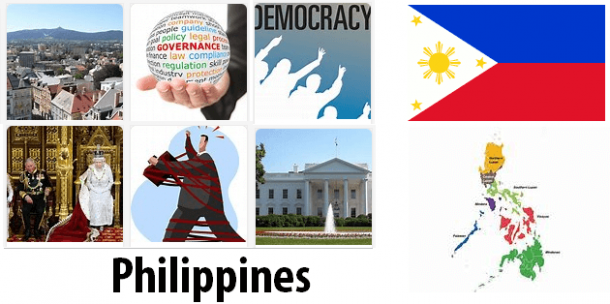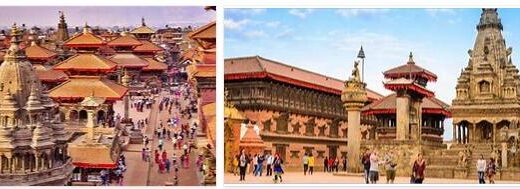Philippines Government and Politics
In April 2005, the Government and the Moro Front announced that, during the initial peace talks in Malaysia, an agreement had been reached on the indigenous territories claimed by the rebels over the previous 3 decades. This topic was the basics of the negotiation process.

The presidential palace declared in June 2005 that it had uncovered a plot to remove Gloria Arroyo due to alleged irregularities in the election process the previous year. Opposition members were accused of participating in the plot, which included was to use a tape that originated from North American officials. On the tape, one could hear Arroyo’s voice urging Election Commission officials to increase her voting share on Mindanao. The tape suggested a possible US involvement in a conspiracy against the president. However, the US Embassy in Manila rejected any knowledge of the tape. Nevertheless, the president’s husband, Jose Miguel Arroyo, volunteered in the United States.
The case triggered massive demonstrations in Manila in June and July demanding the president’s departure. Both Senate President Franklin Drilon, former President Corazon Aquino and several of Arroyo’s ministers who had resigned from their posts called on the president to step down. Unsuccessfully. On July 9, the entire country was declared in alarm mode. Still, the protests in Manila, Baguio, Bacolod, Naga and Cebu continued. In Mindanao, too, the people began to protest. Not with demands for Arroyo’s departure, but with demands for the formation of an independent Mindanao.
Despite calls and massive popular protests, Arroyo clung to power, and in December Freedom House changed the country’s status from “free” to “partially free.” It was the first time this happened since the dictator Ferdinand Marcos was overthrown in 1986.
On February 24, 2006, a coup attempt was made against Arroyo, but it failed. It triggered nationwide state of emergency that lasted until March 3rd. 4 MPs from the left and 12 other opposition leaders were charged with taking part in the coup. But right-wing General Danny Lim and a number of other officers were also arrested. It is unclear if a coup attempt actually took place.
A government report published in February 2007 accused senior military officials of being behind the execution of several hundred left-wing activists in the period since 2001.
The general election campaign up to the parliamentary and municipal elections in May 2007 was, as usual, characterized by extensive violence. Over 300 people were killed during the 3 months leading up to the elections.
In May 2010, parliamentary elections were held. During the election campaign, over 20 were killed: at least 5 candidates and 16 campaign activists, but the months before were even more bloody. In November 2009, 63 people traveling in an opposition candidate’s convoy were killed in Maguindanao province – including 34 journalists. The local governor, Andal Ampatuan Sr. and a number of members of his private army have since been arrested for the murders. Amnesty International said the number of private armies increased from 68 in December to 117 in February. Following the Maguindanao massacre, there were strong calls for President Gloria Arroyo to repeal Directive 546 of 2006 that de-facto legalized private armies, but the president refused. Authorities were generally very slow and reluctant to investigate the circumstances surrounding the numerous murders, let alone solve them.The NPA was reportedly responsible for the murder of one of the 5 candidates, and the military’s 42nd Infantry Battalion was immediately put into the hunt for partisans.
Davao City, General Santos City, Digos City, Tagum City and Cebu City continue to be ravaged by death patrols killing petty criminals, drug dealers and street children. In Davao alone, 89 people were killed by death patrols in the period January-September 2009. That brought the death toll to 926 since 1998. The worst massacre took place on November 23, 2009 outside the city of Ampatuan when 58 were killed. The killers came from the Ampatuan family, which has a standing “army” of 2-5,000 armed members. Very few of the killings have been resolved. Both authorities and courts are very long-suffering in investigations and judicial proceedings. Most often, the authorities do not do enough to protect any witnesses.
The May 2010 presidential election was won by Liberal Benigno Aquino III, who won 42% of the vote. His mother, Corazon Aquino, was president in the late 1980s, and his father Benigno Aquino was assassinated by the dictatorship in August 1983. The mother died in 2009, prompting strong parties in the party to urge the son to stand. Upon his accession, Aquino declared that he would set up a Truth Commission to investigate the corruption charges against former President Gloria Macapagal-Arroyo. It happened in June. In September, he made his first foreign visit – to the old US colonial power.
In August 2010, a fired policeman kidnapped a tourist bus with 20 tourists and 5 Filipinos. The policeman believed he had been unjustly fired and demanded a hearing where he could defend himself. As a result of the police’s hopeless handling of the hostage situation, eight hostages and the policeman were killed while several others were injured. Hong Kong where tourists were advised against subsequent trips to the Philippines.



